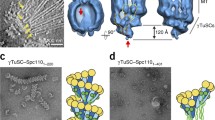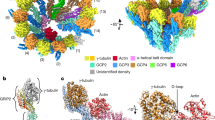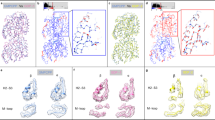Abstract
γ-tubulin is essential for the nucleation and organization of mitotic microtubules in dividing cells. It is localized at the microtubule organizing centers and mitotic spindle fibres. The most well accepted hypothesis for the initiation of microtubule polymerization is that α/β-tubulin dimers add onto a γ-tubulin ring complex (γTuRC), in which adjacent γ-tubulin subunits bind to the underlying non-tubulin components of the γTuRC. This template thus determines the resulting microtubule lattice. In this study we use molecular modelling and molecular dynamics simulations, combined with computational MM-PBSA/MM-GBSA methods, to determine the extent of the lateral atomic interaction between two adjacent γ-tubulins within the γTuRC. To do this we simulated a γ–γ homodimer for 10 ns and calculated the ensemble average of binding free energies of −107.76 kcal/mol by the MM-PBSA method and of −87.12 kcal/mol by the MM-GBSA method. These highly favourable binding free energy values imply robust lateral interactions between adjacent γ-tubulin subunits in addition to their end-interactions longitudinally with other proteins of γTuRC. Although the functional reconstitution of γ-TuRC subunits and their stepwise in vitro assembly from purified components is not yet feasible, we nevertheless wanted to recognize hotspot amino acids responsible for key γ–γ interactions. Our free energy decomposition data from converting a compendium of amino acid residues identified an array of hotspot amino acids. A subset of such mutants can be expressed in vivo in living yeast. Because γTuRC is important for the growth of yeast, we could test whether this subset of the hotspot mutations support growth of yeast. Consistent with our model, γ-tubulin mutants that fall into our identified hotspot do not support yeast growth.









Similar content being viewed by others
References
Oakley BR, Oakley CE, Yoon Y, Jung MK (1990) γ-Tubulin is a component of the spindle pole body that is essential for microtubule function in Aspergillus nidulans. Cell 61(7):1289–1301
Zheng Y, Jung MK, Oakley BR (1991) γ-Tubulin is present in Drosophila melanogaster and Homo sapiens and is associated with the centrosome. Cell 65(5):817–823
Stearns T, Evans L, Kirschner M (1991) γ-Tubulin is a highly conserved component of the centrosome. Cell 65(5):825–836
Horio T, Uzawa S, Jung MK, Oakley BR, Tanaka K, Yanagida M (1991) The fission yeast gamma-tubulin is essential for mitosis and is localized at microtubule organizing centers. J Cell Sci 99(4):693–700
Joshi HC, Palacios MJ, McNamara L, Cleveland DW (1992) γ-Tubulin is a centrosomal protein required for cell cycle-dependent microtubule nucleation. Nature 365:80–83
Joshi HC (1993) γ-Tubulin: the hub of cellular microtubule assemblies. BioEssays 15(10):637–643
Oakley CE, Oakley BR (1989) Identification of γ-tubulin, a new member of the tubulin superfamily encoded by mipA gene of Aspergillus nidulans. Nature 338:662–664
Sui H, Downing KH (2010) Structural basis of interprotofilament interaction and lateral deformation of microtubules. Structure 18(8):1022–1031
Rice LM, Montabana EA, Agard DA (2008) The lattice as allosteric effector: structural studies of αβ-and γ-tubulin clarify the role of GTP in microtubule assembly. Proc Natl Acad Sci 105(14):5378–5383
Wilson EB (1928) The cell in development and heredity, 3rd edn. The Macmillan Co., New York
Li Q, Joshi HC (1995) Gamma-tubulin is a minus end-specific microtubule binding protein. J Cell Biol 131(1):207–214
Oegema K, Wiese C, Martin OC, Milligan RA, Iwamatsu A, Mitchison TJ, Zheng Y (1999) Characterization of two related Drosophila γ-tubulin complexes that differ in their ability to nucleate microtubules. J Cell Biol 144(4):721–733
Zheng Y, Wong ML, Alberts B, Mitchison T (1995) Nucleation of microtubule assembly by a gamma-tubulin-containing ring complex. Nature 378(6557):578–583
Gohlke H, Case DA (2004) Converging free energy estimates: MM-PB (GB) SA studies on the protein–protein complex Ras-Raf. J Comput Chem 25(2):238–250
Gohlke H, Kiel C, Case DA (2003) Insights into protein–protein binding by binding free energy calculation and free energy decomposition for the Ras-Raf and Ras–RalGDS complexes. J Mol Biol 330(4):891–913
Zoete V, Meuwly M, Karplus M (2005) Study of the insulin dimerization: binding free energy calculations and per-residue free energy decomposition. Proteins Struct Funct Bioinf 61(1):79–93
Michalik L, Zoete V, Krey G, Grosdidier A, Gelman L, Chodanowski P, Feige JN, Desvergne B, Wahli W, Michielin O (2007) Combined simulation and mutagenesis analyses reveal the involvement of key residues for peroxisome proliferator-activated receptorα helix 12 dynamic behavior. J Biol Chem 282(13):9666–9677
Stites WE (1997) Protein-protein interactions: interface structure, binding thermodynamics, and mutational analysis. Chem Rev 97(5):1233–1250
Zoete V, Michielin O (2007) Comparison between computational alanine scanning and per-residue binding free energy decomposition for protein–protein association using MM-GBSA: application to the TCR-p-MHC complex. Proteins Struct Funct Bioinf 67(4):1026–1047
Kollman PA, Massova I, Reyes C, Kuhn B, Huo S, Chong L, Lee M, Lee T, Duan Y, Wang W (2000) Calculating structures and free energies of complex molecules: combining molecular mechanics and continuum models. Acc Chem Res 33(12):889–897
Onufriev A, Bashford D, Case DA (2000) Modification of the generalized Born model suitable for macromolecules. J Phys Chem B 104(15):3712–3720
Srinivasan J, Cheatham TE, Cieplak P, Kollman PA, Case DA (1998) Continuum solvent studies of the stability of DNA, RNA, and phosphoramidate-DNA helices. J Am Chem Soc 120(37):9401–9409
Tsui V, Case DA (2000) Theory and applications of the generalized Born solvation model in macromolecular simulations. Biopolymers 56(4):275–291
Lafont V, Schaefer M, Stote RH, Altschuh D, Dejaegere A (2007) Protein–protein recognition and interaction hot spots in an antigen–antibody complex: free energy decomposition identifies “efficient amino acids”. Proteins Struct Funct Bioinf 67(2):418–434
Hess B, Kutzner C, Van Der Spoel D, Lindahl E (2008) GROMACS 4: algorithms for highly efficient, load-balanced, and scalable molecular simulation. J Chem Theory Comput 4(3):435–447
Berendsen H, Postma J, Van Gunsteren W, Hermans J (1981) Intermolecular Forces, ed. B Pullman, Reidel, Dordrecht 331
Darden T, York D, Pedersen L (1993) Particle mesh Ewald: an N· log (N) method for Ewald sums in large systems. J Chem Phys 98(12):10089–10092
Essmann U, Perera L, Berkowitz ML, Darden T, Lee H, Pedersen LG (1995) A smooth particle mesh Ewald method. J Chem Phys 103(19):8577–8593
Ryckaert J-P, Ciccotti G, Berendsen HJ (1977) Numerical integration of the cartesian equations of motion of a system with constraints: molecular dynamics of < i > n </i > -alkanes. J Comput Phys 23(3):327–341
Laskowski RA, MacArthur MW, Moss DS, Thornton JM (1993) PROCHECK: a program to check the stereochemical quality of protein structures. J Appl Crystallogr 26(2):283–291
Ramachandran G, Ct Ramakrishnan, Sasisekharan V (1963) Stereochemistry of polypeptide chain configurations. J Mol Biol 7(1):95–99
Colovos C, Yeates TO (1993) Verification of protein structures: patterns of nonbonded atomic interactions. Protein Sci 2(9):1511–1519
Eisenberg D, Lüthy R, Bowie JU (1997) VERIFY3D: assessment of protein models with three-dimensional profiles. Methods Enzymol 277:396
Case DA, Cheatham TE, Darden T, Gohlke H, Luo R, Merz KM, Onufriev A, Simmerling C, Wang B, Woods RJ (2005) The Amber biomolecular simulation programs. J Comput Chem 26(16):1668–1688
Pearlman DA, Case DA, Caldwell JW, Ross WS, Cheatham TE III, DeBolt S, Ferguson D, Seibel G, Kollman P (1995) AMBER, a package of computer programs for applying molecular mechanics, normal mode analysis, molecular dynamics and free energy calculations to simulate the structural and energetic properties of molecules. Comput Phys Commun 91(1):1–41
Cornell WD, Cieplak P, Bayly CI, Gould IR, Merz KM, Ferguson DM, Spellmeyer DC, Fox T, Caldwell JW, Kollman PA (1995) A second generation force field for the simulation of proteins, nucleic acids, and organic molecules. J Am Chem Soc 117(19):5179–5197
Hornak V, Abel R, Okur A, Strockbine B, Roitberg A, Simmerling C (2006) Comparison of multiple Amber force fields and development of improved protein backbone parameters. Proteins Struct Funct Bioinf 65(3):712–725
Jorgensen WL, Chandrasekhar J, Madura JD, Impey RW, Klein ML (1983) Comparison of simple potential functions for simulating liquid water. J Chem Phys 79(2):926–935
Berendsen HJ, Postma JPM, van Gunsteren WF, DiNola A, Haak J (1984) Molecular dynamics with coupling to an external bath. J Chem Phys 81(8):3684–3690
Honig B, Nicholls A (1995) Classical electrostatics in biology and chemistry. Science, New Series 268:1144–1149
Massova I, Kollman PA (2000) Combined molecular mechanical and continuum solvent approach (MM-PBSA/GBSA) to predict ligand binding. Perspect Drug Discovery Des 18(1):113–135
Sitkoff D, Sharp KA, Honig B (1994) Accurate calculation of hydration free energies using macroscopic solvent models. J Phys Chem 98(7):1978–1988
Guo J, Wang X, Sun H, Liu H, Yao X (2012) The molecular basis of IGF-II/IGF2R recognition: a combined molecular dynamics simulation, free-energy calculation and computational alanine scanning study. J Mol Model 18(4):1421–1430
Zoete V, Irving M, Michielin O (2010) MM–GBSA binding free energy decomposition and T cell receptor engineering. J Mol Recognit 23(2):142–152
Hendrickson TW, Yao J, Bhadury S, Corbett AH, Joshi HC (2001) Conditional mutations in γ-tubulin reveal its involvement in chromosome segregation and cytokinesis. Mol Biol Cell 12(8):2469–2481
Maundrell K (1990) nmt1 of fission yeast. A highly transcribed gene completely repressed by thiamine. J Biol Chem 265(19):10857–10864
Maundrell K (1993) Thiamine-repressible expression vectors pREP and pRIP for fission yeast. Gene 123(1):127–130
Paluh J, Clayton D (1996) A functional dominant mutation in Schizosaccharomyces pombe RNase MRP RNA affects nuclear RNA processing and requires the mitochondrial-associated nuclear mutation ptp1-1 for viability. EMBO J 15(17):4723
Horio T, Oakley BR (1994) Human gamma-tubulin functions in fission yeast. J Cell Biol 126(6):1465–1473
Tsai CJ, Nussinov R (1997) Hydrophobic folding units at protein–protein interfaces: implications to protein folding and to protein–protein association. Protein Sci 6(7):1426–1437
Davis SJ, Davies EA, Tucknott MG, Jones EY, Van Der Merwe PA (1998) The role of charged residues mediating low affinity protein–protein recognition at the cell surface by CD2. Proc Natl Acad Sci 95(10):5490–5494
Wallace AC, Laskowski RA, Thornton JM (1995) LIGPLOT: a program to generate schematic diagrams of protein-ligand interactions. Protein Eng 8(2):127–134
Acknowledgments
The work was supported partially by funding from the United States of America National Institutes of Health R01-CA095317 (H.C. Joshi) and NRSA-GM18037 (T.W. Hendrickson). The authors are thankful to Prof. B. Jayaram and the staff of the SCFBio lab at IIT-Delhi for providing the access to their supercomputing facility to perform MD simulation. Authors are also thankful to Jaypee University of Information Technology for providing fellowship to Miss. Charu Suri.
Author information
Authors and Affiliations
Corresponding author
Rights and permissions
About this article
Cite this article
Suri, C., Hendrickson, T.W., Joshi, H.C. et al. Molecular insight into γ–γ tubulin lateral interactions within the γ-tubulin ring complex (γ-TuRC). J Comput Aided Mol Des 28, 961–972 (2014). https://doi.org/10.1007/s10822-014-9779-2
Received:
Accepted:
Published:
Issue Date:
DOI: https://doi.org/10.1007/s10822-014-9779-2




